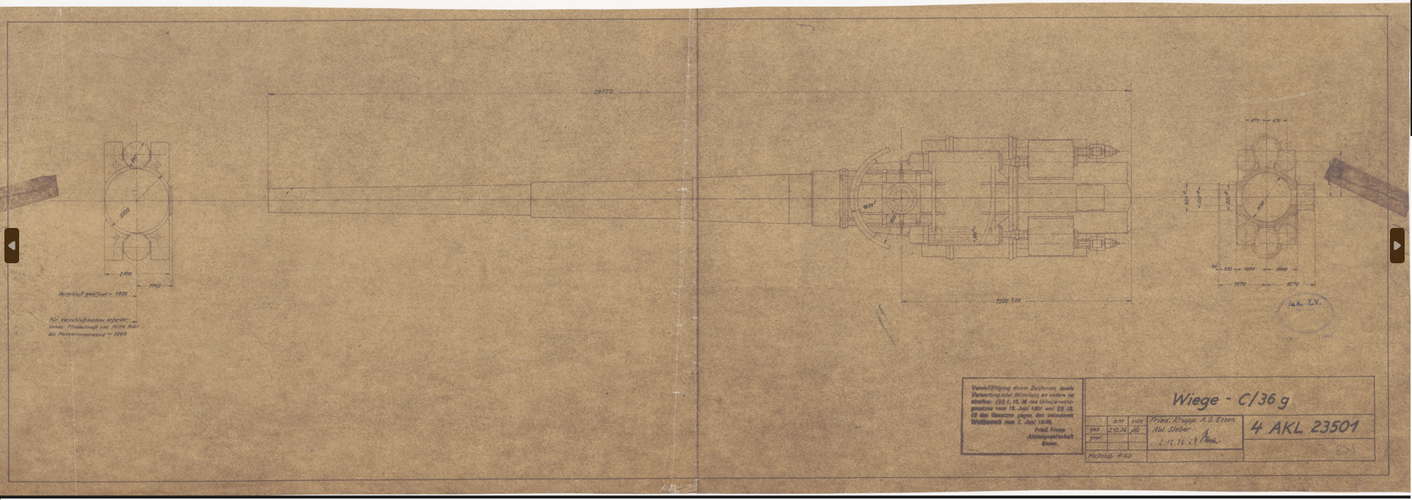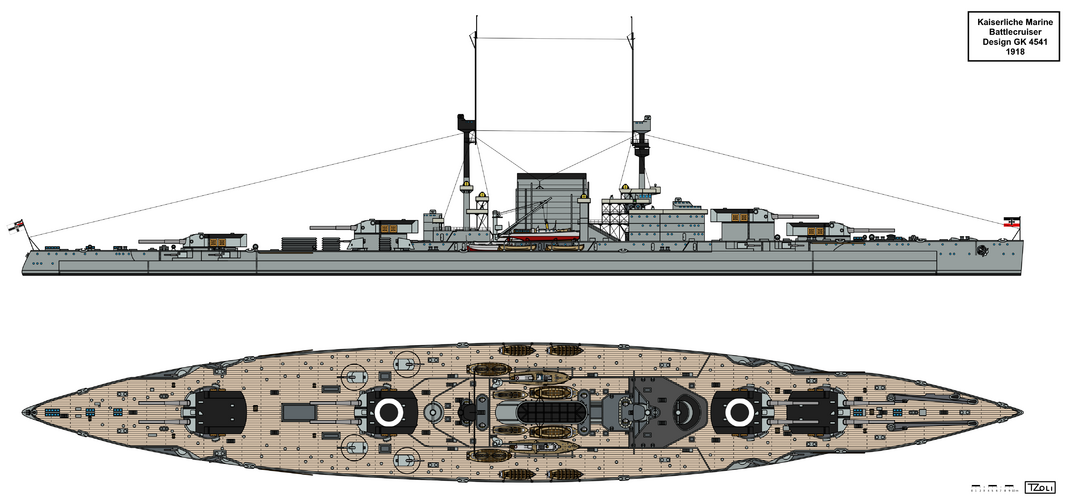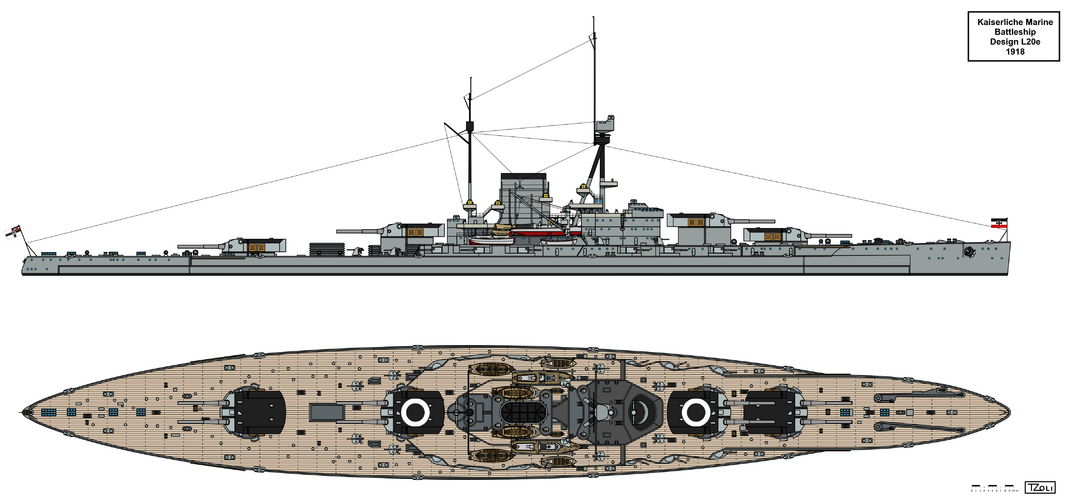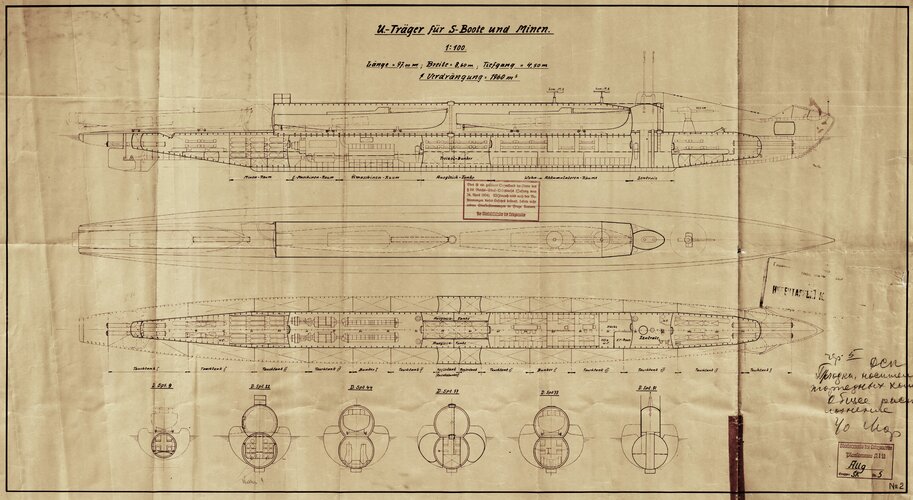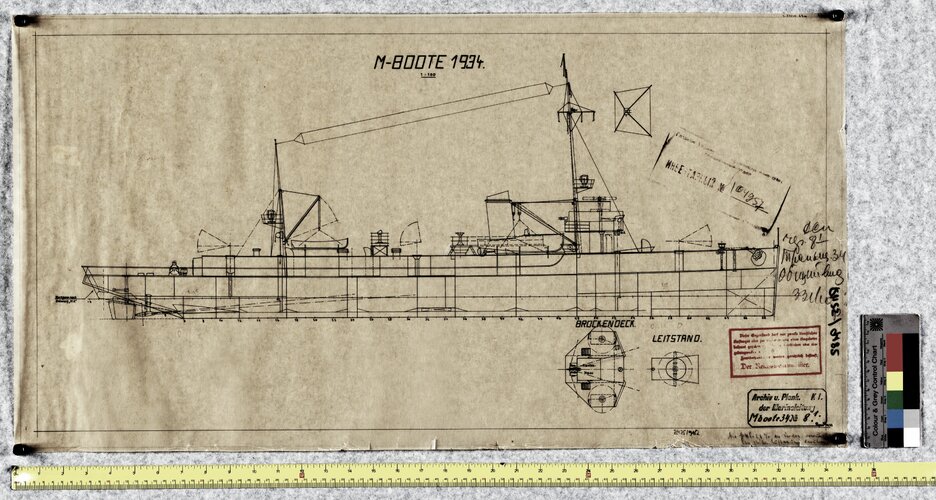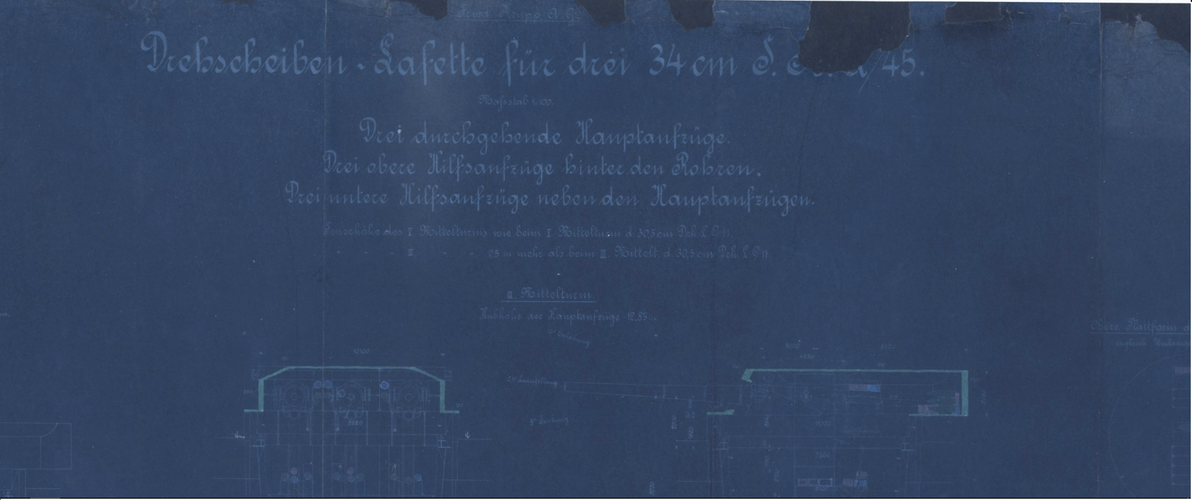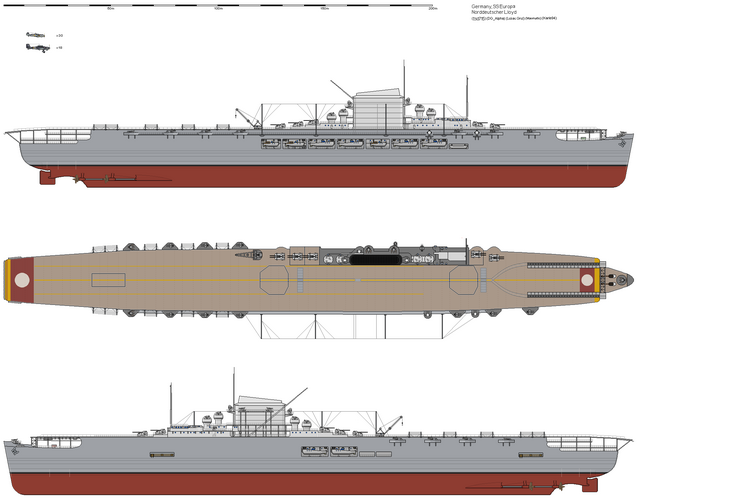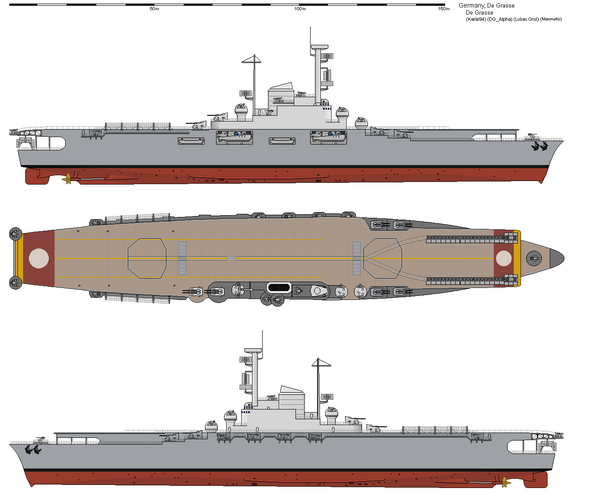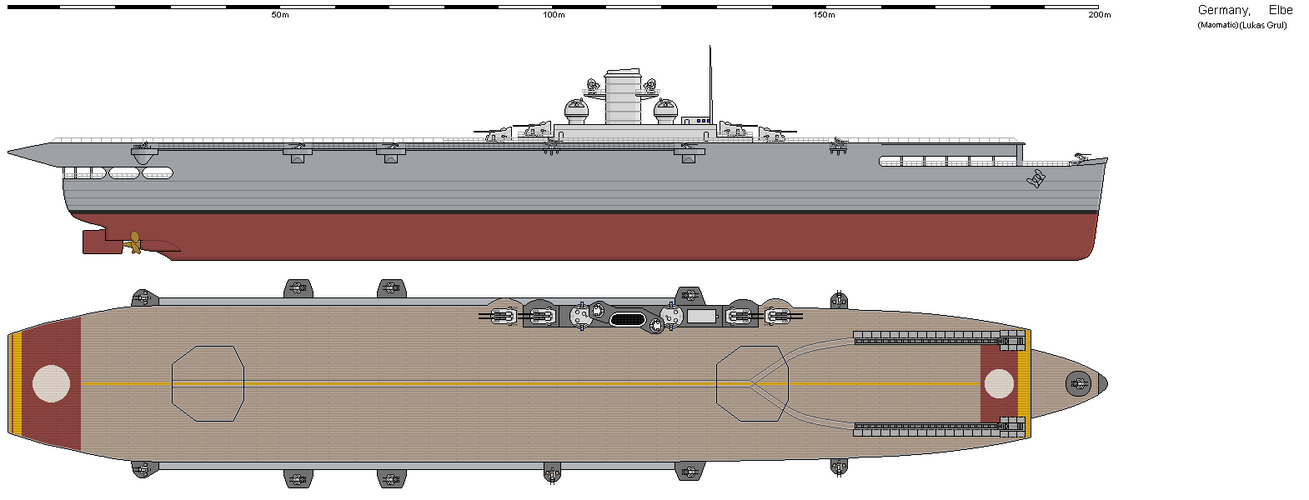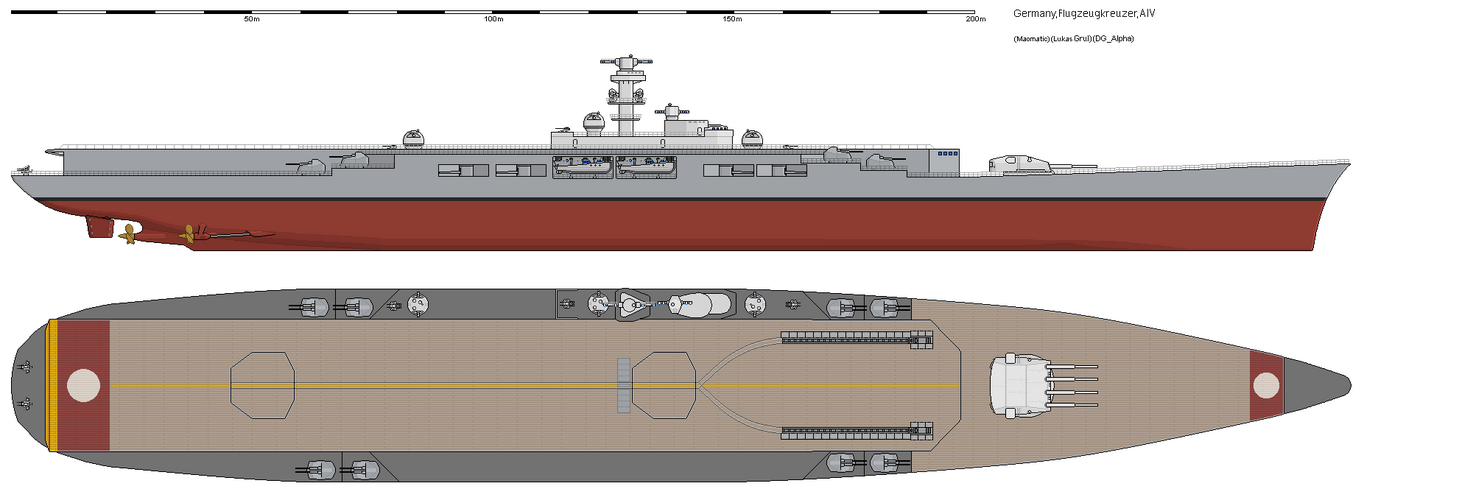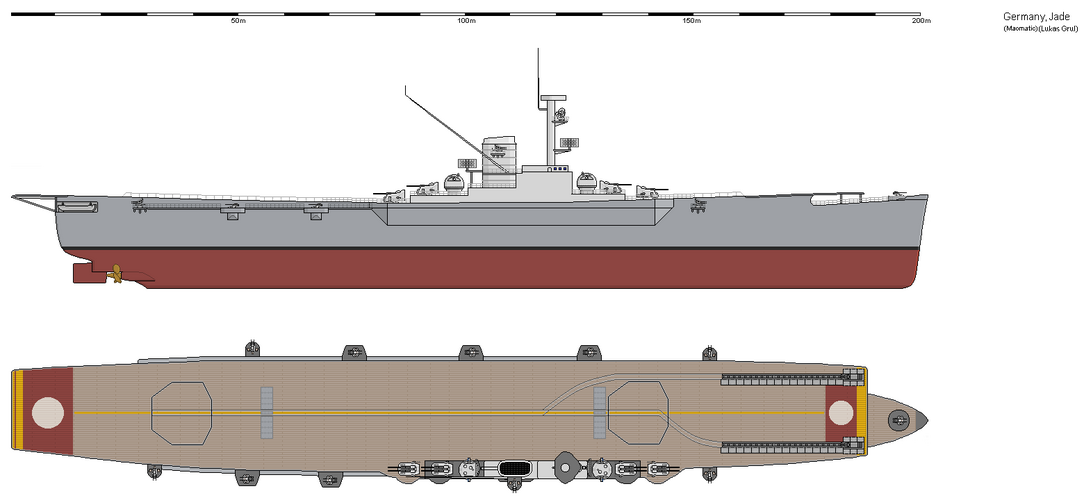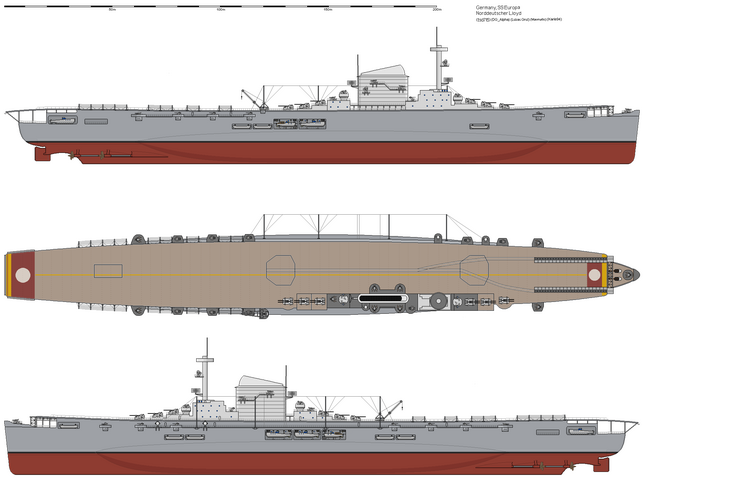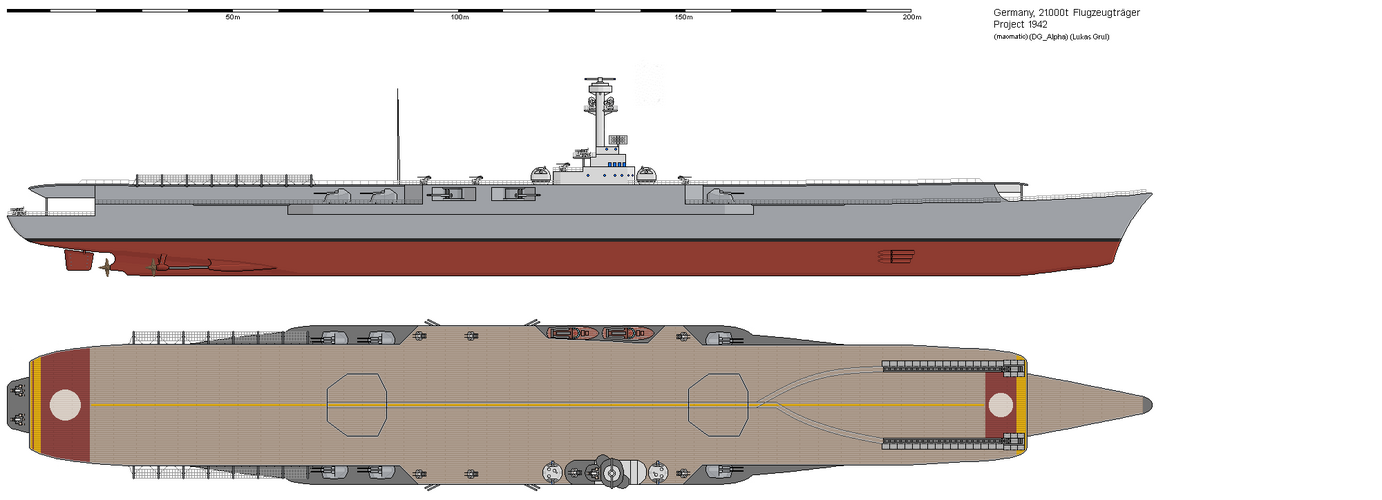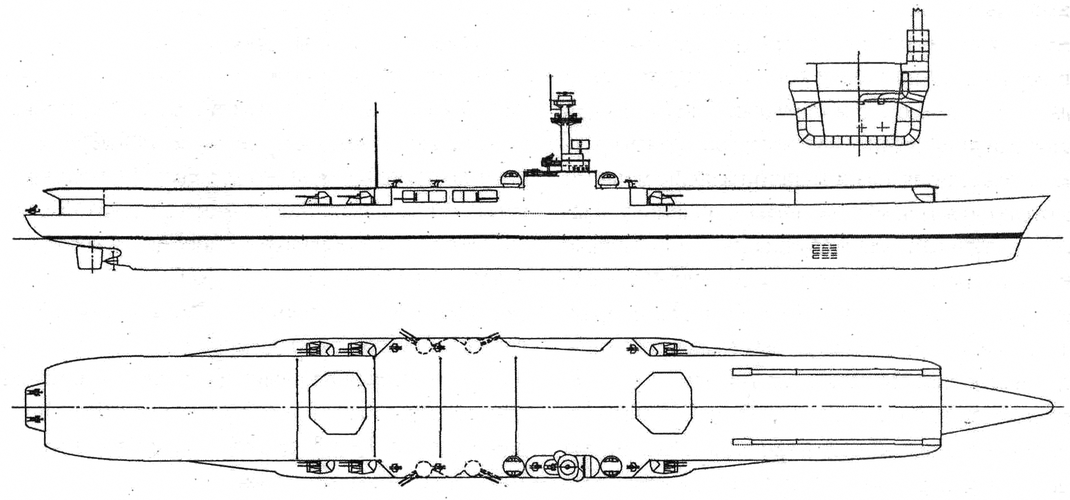You are using an out of date browser. It may not display this or other websites correctly.
You should upgrade or use an alternative browser.
You should upgrade or use an alternative browser.
KRIEGSMARINE CENTRAL - KM Ship Plans/Discussion
- Thread starter _Sarcasticat_
- Start date
Could you provide the hi-res resource, or the doc serial number in Bundesarchiv?Here's another c/36g, this one have total length of 28150m, longer than 53cm/52 barrel (27700m) and designed in 1936.
Initially i want to upload directly from invenio but the file size are massive, i have to minimize a bit.Could you provide the hi-res resource, or the doc serial number in Bundesarchiv?
Anyway is RH 8/3024K, this folder contain various gun barrels (5cm, 20.3cm/L60, 28cm/L58 and this c36/g etc).
_Sarcasticat_
Die Katze.
- Joined
- 16 April 2020
- Messages
- 319
- Reaction score
- 264
Yes, this is the 28cm-SK L/58 C38 V that Breyer mentions...didn't expect to see a drawing for it, though.Here's another c/36g, this one have total length of 28150m, longer than 53cm/52 barrel (27700m) and designed in 1936.
View attachment 718594
There's also a 28.3cm/L58 (designated as C38) barrel as well, i recalled this was mentioned in Siegfried Breyer book (on the P-class cruiser pages).
This new 53cm is rather curious. A very early version?
Was there ever more work on this topic? Are there any dimensions available for the possible upgraded Deutschlands?Hello everyone, I'm back again.
Today's topic is the Deutschland rebuilds. / and me throwing a bunch of diesel engine development at the screen because I can't help but explain every little facet and detail.
/// REVISION UNDERWAY, PLEASE STAND BY. ///
_Sarcasticat_
Die Katze.
- Joined
- 16 April 2020
- Messages
- 319
- Reaction score
- 264
Ah, I forgot. Things have been busy, and I have been finally able to go home after some months, so everything's on a pause regardless. The only thing I wanted to add was to simply explain that the war stunted a lot of the big plans, and the engines would not have been ready in time for the originally scheduled rebuilds anyway iirc.Was there ever more work on this topic? Are there any dimensions available for the possible upgraded Deutschlands?
As for dimensions, at this time no. They're around almost for sure, but they aren't digitized yet. What's been uncovered at the US National Archives is only a tithe of what's actually there as well, so it might be there. Such a thing hasn't even been identified either, so I couldn't even tell you if it's in Germany or the US.
- Joined
- 1 February 2011
- Messages
- 2,615
- Reaction score
- 2,558
Did the Krupp actually build 457 and 508mm cannons?
Although a fascinating subject, I believe this to be in another thread, not on a Kriegsmarine one. Hochseeflotte should do the trick.Hello, I wanted to ask if you could recommend any book or online archive on German battleship designs, preferably from the first decade of the 20th century (1908-1911).
I am investigating the negotiations between German companies (Blohm & Voss, Germaniawerf, Schichau, Vulcan, Weser, etc.) with Argentina or Brazil; and although I have details of some of the proposals, I have not yet been able to find all the schemes.
In particular, I am obsessed to find a proposal for battleships for Argentina by Blohm & Voss, offered circa July 1909 and called "Design G." Its characteristics were:
- Displacement: 20,165.
- Medium draft: 8.1 meters.
- Power: ~24,500 hp.
- Machinery: Turbines.
- Speed: 22.0-20.5 ks.
- Belt: 230 mm.
- Main guns: 15 (5x3) 305mm/50cs.
- Secondary guns: 12 (12x1) 152mm/50cs.
- Tertiary guns: 12 (12x1) 75mm/50cs.
- Torpedo launchers: 4 (4x1) ~533mm tt.
Thank you very much for your attention. regards.
_Sarcasticat_
Die Katze.
- Joined
- 16 April 2020
- Messages
- 319
- Reaction score
- 264
I don't want to discourage talk about the HSF/Kaiserliche Marine since we have talked about it before, but to be honest @COLDOWN I do not have many sources on that era. Not anything that might help you find more information on this Design G you're referring to, unfortunately. If I happen to come across it, I'll send what I find to you.
_Sarcasticat_
Die Katze.
- Joined
- 16 April 2020
- Messages
- 319
- Reaction score
- 264
It would not at all surprise me if they built guns for testing, they do not appear to have been seriously considered for naval application. 42cm seems to have been their limit, mostly at the behest of the Kaiser.Did the Krupp actually build 457 and 508mm cannons?
- Joined
- 1 February 2011
- Messages
- 2,615
- Reaction score
- 2,558
Digitalized files, archives and documents on HSF/Imperial Navy still going fast, am waiting until these get digitalize:
- "Battleship with twin 34cm turret".
- "Fast-battleships, battlecruisers with triple and quadruple turrets" (dated 1918).
- "Study of triple 30.5cm turret".
A fews have been digitalized so far are:
- A 26500 tons pre-design of König-class with 4 triple 30.5cm turrets.
- German Admiralty? logbook on Austrian-Hungarian battleship Tegetthoff including their inspecting, feedback on her triple 30.5 turret (with turret sketches and interiors).
- Sketch of twin and triple 34cm turret, the triple turret print have the description above comparing the placement of twin 30.5cm turret, indicating this was proposed for König-class as well.
- Mackensen-class battlecruiser preliminary designs.
There are other various and scattered files on RM 3/6 and /9 as well, but there too many to put in.
- "Battleship with twin 34cm turret".
- "Fast-battleships, battlecruisers with triple and quadruple turrets" (dated 1918).
- "Study of triple 30.5cm turret".
A fews have been digitalized so far are:
- A 26500 tons pre-design of König-class with 4 triple 30.5cm turrets.
- German Admiralty? logbook on Austrian-Hungarian battleship Tegetthoff including their inspecting, feedback on her triple 30.5 turret (with turret sketches and interiors).
- Sketch of twin and triple 34cm turret, the triple turret print have the description above comparing the placement of twin 30.5cm turret, indicating this was proposed for König-class as well.
- Mackensen-class battlecruiser preliminary designs.
There are other various and scattered files on RM 3/6 and /9 as well, but there too many to put in.
00-PureEvil-00
ACCESS: Restricted
- Joined
- 5 September 2021
- Messages
- 13
- Reaction score
- 14
We give you a boat-carrying boat so you can enjoy some boats while sitting in a boat.Project of a submarine - a carrier of boats and a mine depositor. Circa 1934.
(Yeah, my sense of humor is even worse than my English. I'm not sorry for that.)
P.S. And now I wonder if a flying boat can be stuffed into this thing's hangar, for full combo.
gollevainen
ACCESS: Confidential
- Joined
- 2 May 2007
- Messages
- 131
- Reaction score
- 167
I think these may be from the Mackensen preminaly stages, when the armament options ranged from 30.5cm-38cm and everything between. Only alternative caliber mentioned for the Köning class Ive seen in the publications over the matter is the quriky 32.2cm which I think never actually existed outside theorethical thinking.- Sketch of twin and triple 34cm turret, the triple turret print have the description above comparing the placement of twin 30.5cm turret, indicating this was proposed for König-class as well.
An itherto unknown version of the Type III, with an unknown to me Schnellboote design. No mines, rather oxygen flasks.Project of a submarine - a carrier of boats and a mine depositor. Circa 1934.
Do you have a link to the Mackensen preliminaries?Digitalized files, archives and documents on HSF/Imperial Navy still going fast, am waiting until these get digitalize:
- "Battleship with twin 34cm turret".
- "Fast-battleships, battlecruisers with triple and quadruple turrets" (dated 1918).
- "Study of triple 30.5cm turret".
A fews have been digitalized so far are:
- A 26500 tons pre-design of König-class with 4 triple 30.5cm turrets.
- German Admiralty? logbook on Austrian-Hungarian battleship Tegetthoff including their inspecting, feedback on her triple 30.5 turret (with turret sketches and interiors).
- Sketch of twin and triple 34cm turret, the triple turret print have the description above comparing the placement of twin 30.5cm turret, indicating this was proposed for König-class as well.
- Mackensen-class battlecruiser preliminary designs.
There are other various and scattered files on RM 3/6 and /9 as well, but there too many to put in.
Mines could be loaded instead of boats.An itherto unknown version of the Type III, with an unknown to me Schnellboote design. No mines, rather oxygen flasks.
You are right, those are LMB mines, but not carried instead of boats. They were supposed to be launched through the aft "torpedo" tubes.Mines could be loaded instead of boats.
Last edited:
- Joined
- 11 March 2006
- Messages
- 8,608
- Reaction score
- 3,057
"Drehscheiben-Lafette für drei 34cm ?. ???/45
Drei durchgehende Hauptaufzüge
Drei obere Hilfsaufzüge hinter den Rohren
Drei untere Hilfsaufzüge neben den Hauptaufzügen
Feuerhöhe des 1.Mittelturms wie beim 1.Mittelturm d. 30,5cm Dreh.L. /11
" 3. " 0,5m mehr als beim 3. Mittelturm d. 30,5cm Dreh.L. /11
3 (III.).Mittelturm
Hubhöhe des Hauptaufzugs 12,85m"
=
Turntable gun mount for three 34cm ?.??/45
Three continuous main lifts
Three upper auxiliary lifts behind the guns
Three lower auxiliary lifts beside main lifts
height of fire of the first middle turret, as for the first middle turret with 30,5cm Dreh.L. /11
height of fire of the third middle turret, 0.5 m more, than for the thirdmiddle turret with 30,5cm Dreh.L. /11
third middle turret
lifting height of the main lift 12.85 m
Sorry, the parts marked with ? are still not clear to me, but I have someone, who is quite good at old fonts ...
so, to be continued
Drei durchgehende Hauptaufzüge
Drei obere Hilfsaufzüge hinter den Rohren
Drei untere Hilfsaufzüge neben den Hauptaufzügen
Feuerhöhe des 1.Mittelturms wie beim 1.Mittelturm d. 30,5cm Dreh.L. /11
" 3. " 0,5m mehr als beim 3. Mittelturm d. 30,5cm Dreh.L. /11
3 (III.).Mittelturm
Hubhöhe des Hauptaufzugs 12,85m"
=
Turntable gun mount for three 34cm ?.??/45
Three continuous main lifts
Three upper auxiliary lifts behind the guns
Three lower auxiliary lifts beside main lifts
height of fire of the first middle turret, as for the first middle turret with 30,5cm Dreh.L. /11
height of fire of the third middle turret, 0.5 m more, than for the thirdmiddle turret with 30,5cm Dreh.L. /11
third middle turret
lifting height of the main lift 12.85 m
Sorry, the parts marked with ? are still not clear to me, but I have someone, who is quite good at old fonts ...
so, to be continued
Last edited:
"34cm S.K L/45"Seems, that we can reduce the number of question marks.
View attachment 720717
"34cm S.S.../45"
still not quite clear
View attachment 720718
I'm leaning to "30,5cm Drh. L. ?/11"
"30.5cm Drh L C/11" seems pretty obvious and thank you for the translations.
lukasgrul
ACCESS: Confidential
- Joined
- 15 May 2021
- Messages
- 101
- Reaction score
- 41
If anybody is interested, here are some carriers that I drew in shipbucket style.
Attachments
TheWayOfTheWind
ACCESS: Restricted
- Joined
- 25 February 2024
- Messages
- 5
- Reaction score
- 0
Sorry if this is a bit lazy and that if I dug I could find the answer, but how much does it cost to digitalize these plans?
I also was wondering also if they have stuff that isn't listed on the archive website?
I am currently trying to get as many plans as possible of the type IX U-boat for an intricate modelling project, I got a decent chunk of them, but still missing some stuff.
I contacted the archive, but it may be a while.
Thanks.
I also was wondering also if they have stuff that isn't listed on the archive website?
I am currently trying to get as many plans as possible of the type IX U-boat for an intricate modelling project, I got a decent chunk of them, but still missing some stuff.
I contacted the archive, but it may be a while.
Thanks.
TheWayOfTheWind
ACCESS: Restricted
- Joined
- 25 February 2024
- Messages
- 5
- Reaction score
- 0
Taking a while for these guys to reply at the Bundesarchive.
TheWayOfTheWind
ACCESS: Restricted
- Joined
- 25 February 2024
- Messages
- 5
- Reaction score
- 0
So I've recently been told that the only practical way somebody can go look for plans is to go in person, has anybody been to Freiburg or live near there? How much would you charge to go there for me and look for IX U-boat plans?
Edit: I've gotten word that if I want plans that are not on Invenio, I have to get an employee to get it for me as they are non public...?
Edit: I've gotten word that if I want plans that are not on Invenio, I have to get an employee to get it for me as they are non public...?
Last edited:
_Sarcasticat_
Die Katze.
- Joined
- 16 April 2020
- Messages
- 319
- Reaction score
- 264
Well doneFew days ago I finished a drawing of 21000t aircraft carrier project.
_Sarcasticat_
Die Katze.
- Joined
- 16 April 2020
- Messages
- 319
- Reaction score
- 264
Yes, you will need someone who will be able to search for what you are looking for. Private investigator/historical investigator, etc. Some only go by what's got a number and a name, but others will actually dig for what you're after. They cost a pretty penny though. I would know. Big list? 1k+ Euro.So I've recently been told that the only practical way somebody can go look for plans is to go in person, has anybody been to Freiburg or live near there? How much would you charge to go there for me and look for IX U-boat plans?
Edit: I've gotten word that if I want plans that are not on Invenio, I have to get an employee to get it for me as they are non public...?
TheWayOfTheWind
ACCESS: Restricted
- Joined
- 25 February 2024
- Messages
- 5
- Reaction score
- 0
I hear that a researcher won't be able to access my holdings directly that they are non public, that only an employee can look through them, which I believe costs an exorbitant amount of money, I believe 200 euro an hour, almost 3 times as much as a private researcher.Yes, you will need someone who will be able to search for what you are looking for. Private investigator/historical investigator, etc. Some only go by what's got a number and a name, but others will actually dig for what you're after. They cost a pretty penny though. I would know. Big list? 1k+ Euro.
Last edited:
Have re-read what M. J. Whitley had to say on the proposed rebuilds of the Deutschland class that was agreed in 1938 and a number of points could be concluded. I'm referencing page 30 of the 1989 publication of German Capital Ships of World War Two.Ah, I forgot. Things have been busy, and I have been finally able to go home after some months, so everything's on a pause regardless. The only thing I wanted to add was to simply explain that the war stunted a lot of the big plans, and the engines would not have been ready in time for the originally scheduled rebuilds anyway iirc.
As for dimensions, at this time no. They're around almost for sure, but they aren't digitized yet. What's been uncovered at the US National Archives is only a tithe of what's actually there as well, so it might be there. Such a thing hasn't even been identified either, so I couldn't even tell you if it's in Germany or the US.
The increase in length appears to be by lengthening the bows (which presumably means no changes required to the rudder and shaft arrangements that might have been required it the stern lengthened as well). A more austere rebuild option "if the major refit was on unacceptable on cost and/or time grounds", notes that if that it would mean "the bows could not be rebuilt"
The 15.cm and 8.8cm/10.5cm batteries were planned to be unchanged. The more austere rebuilt suggests saving weight "the only alternative was to remove the torpedoes, saving 45 tonnes because the Fleet Commander would not allow the 15cm battery to be reduced.
The increase in beam may have been the earlier proposed change to the bulges but not clear if a different concept was planned.
Nothing explicit on replacing the machinery - but 50 tonnes added to the machinery weight.
The major refit was approved as Entwurf I in November 1938 as you have noted "had an increase beam and length. This had given very favourable tank trials and shown just how unfavourable the current ships' lines were. It was true this plan would involve more work than the beam [increase] only plan [Entwurf B], but would only take three months more. This rebuild would allow the ships to have improved splinter protection, better stability, seaworthiness and strength, as well as a 2 knot speed increase. Thus the work was well worth it from the technical point of view. Displacement would rise by 750 tonnes, made up of 500 tonnes for hull widening, lengthening and splinter protection using new steels, 100 tonnes for new equipment, 50 tonnes for machinery and a reserve of 100 tonnes."
Earlier on the page there is a summary of what might fit in the 100 tonnes new equipment category.
30 tonnes for strengthening the main motors
3 tonnes for N. V. A. special equipment (radar)
10 tonnes for improved aerials
5 tonnes for improved aircraft facilities [changing the He 60C for Ar 196A/]
19 tonnes for stabilization to the searchlights
20 tonnes for splinter protection to the free-standing guns
The total weight growth was estimated at 71. 2 tonnes for Deutschland, 71.7 tonnes for Admiral Scheer and 76.7 tonnes for Admiral Graf Spee.
Not as exciting as your Umbau-Panzerschiff Admiral Scheer rebuild. Is it possible that the plans you found for the diesel engines, Entwurf II, with the V7Z 42/58 engines, which did seem to fit the available space might have been meant for these rebuilds (with a possible beam increase) or were those engines also not yet designed too?
Last edited:
TheWayOfTheWind
ACCESS: Restricted
- Joined
- 25 February 2024
- Messages
- 5
- Reaction score
- 0
What scanning services do you guys use for the plans if you don't use the Bundesarchive's free service?
_Sarcasticat_
Die Katze.
- Joined
- 16 April 2020
- Messages
- 319
- Reaction score
- 264
I am now looking at the same source as you, and there seems to be some disagreement for the armament, but it looks like Carls did prefer the 12.7cm DP battery and this most likely would have come to pass.Have re-read what M. J. Whitley had to say on the proposed rebuilds of the Deutschland class that was agreed in 1938 and a number of points could be concluded. I'm referencing page 30 of the 1989 publication of German Capital Ships of World War Two.
The increase in length appears to be by lengthening the bows (which presumably means no changes required to the rudder and shaft arrangements that might have been required it the stern lengthened as well). A more austere rebuild option "if the major refit was on unacceptable on cost and/or time grounds", notes that if that it would mean "the bows could not be rebuilt"
The 15.cm and 8.8cm/10.5cm batteries were planned to be unchanged. The more austere rebuilt suggests saving weight "the only alternative was to remove the torpedoes, saving 45 tonnes because the Fleet Commander would not allow the 15cm battery to be reduced.
The increase in beam may have been the earlier proposed change to the bulges but not clear if a different concept was planned.
Nothing explicit on replacing the machinery - but 50 tonnes added to the machinery weight.
The major refit was approved as Entwurf I in November 1938 as you have noted "had an increase beam and length. This had given very favourable tank trials and shown just how unfavourable the current ships' lines were. It was true this plan would involve more work than the beam [increase] only plan [Entwurf B], but would only take three months more. This rebuild would allow the ships to have improved splinter protection, better stability, seaworthiness and strength, as well as a 2 knot speed increase. Thus the work was well worth it from the technical point of view. Displacement would rise by 750 tonnes, made up of 500 tonnes for hull widening, lengthening and splinter protection using new steels, 100 tonnes for new equipment, 50 tonnes for machinery and a reserve of 100 tonnes."
Earlier on the page there is a summary of what might fit in the 100 tonnes new equipment category.
30 tonnes for strengthening the main motors
3 tonnes for N. V. A. special equipment (radar)
10 tonnes for improved aerials
5 tonnes for improved aircraft facilities [changing the He 60C for Ar 196A/]
19 tonnes for stabilization to the searchlights
20 tonnes for splinter protection to the free-standing guns
The total weight growth was estimated at 71. 2 tonnes for Deutschland, 71.7 tonnes for Admiral Scheer and 76.7 tonnes for Admiral Graf Spee.
Not as exciting as your Umbau-Panzerschiff Admiral Scheer rebuild. Is it possible that the plans you found for the diesel engines, Entwurf II, with the V7Z 42/58 engines, which did seem to fit the available space might have been meant for these rebuilds (with a possible beam increase) or were those engines also not yet designed too?
My personal thoughts as of right now are that the engine upgrades and the alterations to the hull of the ship are two separate operations running in parallel at the same time, but only cross each other one way: the Umbau-Panzerschiffe using data from the tank model, but no speculation/ideas (as that is all they are, practically) about the engine replacement would factor into the rebuild until more research and data would become available. Just the alteration in lines would have yielded an increase in speed of two knots to 28-30 (28 service, 30 absolute max), meaning that all the additional work for new engines might have had much less priority but was still under investigation.
I do not think at any point that the beam-only plan would have ever gone through, as it is only detrimental in terms of speed and seakeeping. My understanding is that the austere plan only includes non-structural changes (with the exception of engine foundation strengthening, which is critical).
The width modification is difficult to ascertain as to whether it is in regards to bulges only or the hull itself. I would think both, but I do not know for sure.
As for the V7Z/V8Z combo, it's easy to find the rough dimensions of the engines - they're the same as the in-lines, just with another set of cylinders and each row at an angle. Lengths per additional cylinders wouldn't change compared to that of the in-line. So even though the V-type engine was likely only still in the early development phase during late 1938, having a rough drawing of a 42/58 engine of various cylinder numbers (V4Z, V7Z, V8Z, V12Z, the like) is an easy thing to do.

